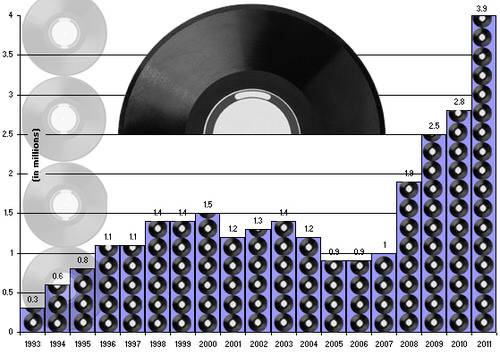It seems like every advance in digital music brings with it a debate about whether the latest format degrades quality in exchange for convenience. This was true when CDs first came onto the scene, and it’s probably even more true today with MP3s and their digital audio brethren. Heck, even the advent of the gramophone in 1889 sparked debates over whether its sound quality was worse than Thomas Edison’s phonograph.

Last week, rock veteran Neil Young chimed in with his assertion that the digital music files we listen to today are of much lower quality than the original recordings. Speaking at the D: Dive Into Media conference, he said that the technology now exists to deliver much higher-quality audio to music fans, and that he had even talked to Steve Jobs about a possible solution.
It is certainly true that an MP3 file, by definition, is of lower quality than the original recording. The files that sit on the hard drives of recording studio engineers are massive – several gigabytes apiece – compared to the file consumers eventually download or stream. To get those MP3 file sizes down, the audio has to be compressed substantially. It’s inevitable that some of the detail will get lost in the process.
How Serious is the Problem? … And How to Fix It?
Exactly how bad is this problem? By Young’s estimation, what we hear in most files today is “only 5% of the data of the original recording”. That may be a slight exaggeration, depending on how the files are encoded. Certainly, lower bit rate files (such as 128kbps MP3s) have a noticeably degraded quality to them, compared to a CD. But most sources have graduated to higher quality files now that broadband speeds allow for it. A standard track on iTunes is a 256kbps AAC file and premium Spotify subscribers can listen to many songs at 320kbps, which is about 22% of a CD track’s bit rate.

When it comes to streaming audio on mobile devices, the quality buck pretty much stops at whatever the data connection can handle. On 3G networks, streaming CD-quality audio just isn’t feasible. Over a good WiFi connection, things look a little more promising, but there are still limitations if the user experience is to be preserved.
Young: We Need an iPod For Audiophiles
So what does Young propose as a solution? From the sound of it, he’d like to see a sort of mega-iPod with more disk space and internal guts optimized to playback massive files. Such a device wouldn’t be designed to include one’s entire library, but rather only a selection of audiophile-quality albums. Presumably, it would tend to be used with superior quality earphones or speakers, which is another important factor in the quality of what we hear.
Even if a device akin to what Young describes were produced and sold, how big of a market would there be for it? The quality of the audio found on sources like iTunes, Spotify, MOG, Amazon and Google Music is apparently good enough to convince millions of people to pay for access to it. At the end of the day, most of the content on the pay music services is certainly good enough. Musicians and audiophiles can pick up on the degradations in quality, but for the average listener, it’s pretty subtle. The device that Young describes would have to be marketed toward the audiophiles for whom 320kbps simply won’t cut it.
Last week wasn’t the first time Young has criticized the state of digital music. Some may dismiss his stance as nothing more than a grumpy, old-school perspective, as though he’s just an old guy that doesn’t get the new-fangled ways of the Web and digital media. This isn’t the case. Young may be a veteran of the music industry, but he’s well aware of what’s changed about it and why. During the same interview in which he slammed MP3’s, he said that “piracy is the new radio” and encouraged new artists to forgo record labels in favor of doing it themselves.
There’s Nothing Wrong With Analog

As Young pointed out, Steve Jobs may have been a digital music pioneer, but “when he went home, he listened to vinyl.” This is true not only of the generation that grew up on LPs, but also of a growing number of younger music fans today. Vinyl sales have been surging for the last few years, with 2011 seeing a 39% increase in sales over the previous year. Digital music sales grew last year too, but by considerably less.
For music fans with the deepest concern for audio quality, it seems analog is increasingly the way to go. That’s okay. We can have our digital revolution in music and still fall back on analog formats. Just like with books, the value offered by digital music is primarily about volume, convenience and ease of production and distribution. And just like sitting down with a good, paper-bound book, putting on a vinyl record is more about quality and the overall experience.
Digital and Analog Can Coexist Peacefully
Digital and analog don’t need to be at war with one another. What many labels and artists are doing now is sell records on vinyl and include a coupon for a free, high-quality digital download in the record’s sleeve. That allows people to enjoy the album as it was intended and also throw it onto their iPod or smartphone for listening on the go.
It’s also possible to go the high-quality route in a digital-only format. When The Beatles’ catalogue was remastered and reissued in 2009, the material was released on CD and, for the first time, via iTunes. For diehard fans who wanted more than what iTunes could offer, they also sold an apple-shaped (no, not that Apple) thumb drive containing every album in superior quality, lossless FLAC format, as well as as 320kbps MP3s.
However things may evolve, it’s evident that digital music has brought us great value, but it’s done so at a cost, namely quality. This may not be perceived as a problem by every consumer, but for those who take the craft of creating and recording music most seriously, it’s one well worth solving. Whether it’s solved through a hybrid of analog and digital music consumption or through some new, high-capacity device for playing back lossless digital audio, the challenge isn’t an insurmountable one.
Vinyl sales chart courtesy of Digital Music News.










